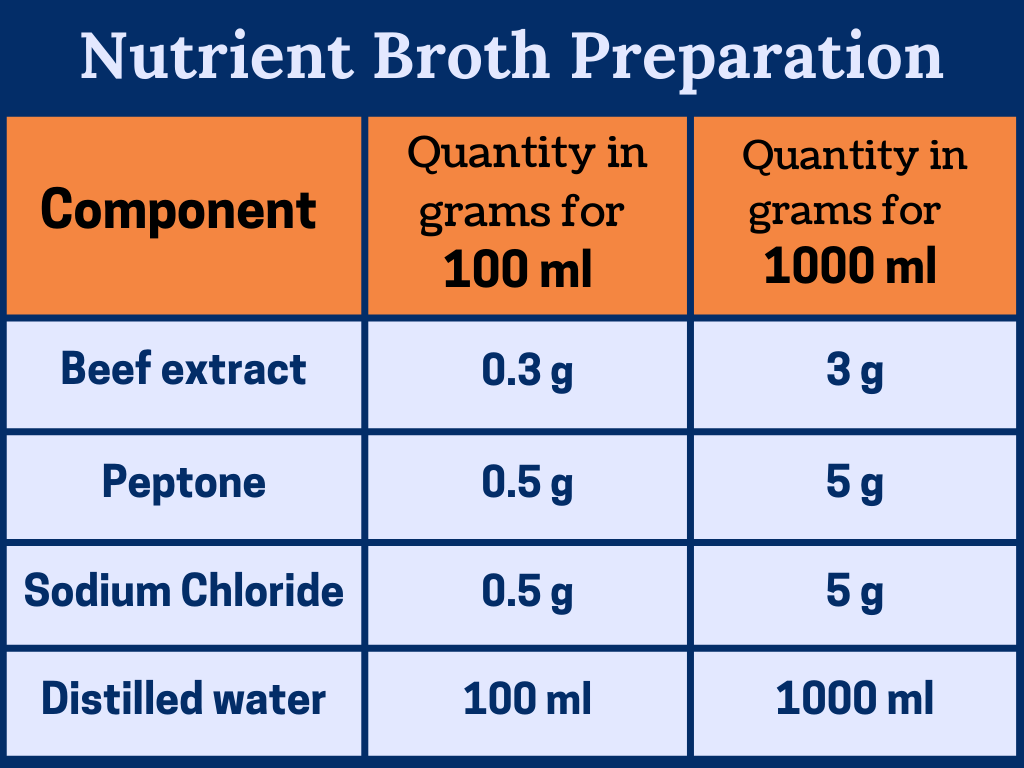Nutrient broth is a microbial culture medium. Microbial culture media without solidifying agents such as agar and gelatin are known as liquid media. Another name for liquid media is liquid broth. The liquid broth is used to grow bacteria in large volumes. Examples of liquid broth media are nutrient broth, tryptic soy broth, yeast extract broth, etc. Preparation of nutrient broth is very simple. The nutrient broth composition is made in such a way that it supports the growth of most bacteria. In this article we will see how to make nutrient broth media to grow the bacteria in laboratory.
The focus of this article will be on
1) Nutrient broth composition and uses
2) How to prepare nutrient broth media for microbiological work.
What is nutrient broth?
A nutrient broth is a liquid medium in microbiology to grow microbes, mainly bacteria.
As per physical consistency nutrient broth is liquid media.
If you categorize nutrient broth by use, it falls into the category of simple media. It is a general-purpose media that supports the growth of most bacteria.
The nutrient broth’s main ingredients are peptone and beef extract which provide individual chemical components like nitrogen, amino acids, organic carbon, and inorganic salt.
Since we do not know the exact amount of each individual chemical component contained in peptone and beef extract it is also a complex media.
Nutrient broth composition
The main ingredients in nutrient broth are peptone, beef extract, and sodium chloride.
Peptone:
Peptone is a protein which is partly digested. It is a complex mixture of amino acids and polypeptides. Peptone is a rich source of organic nitrogen. Peptone is the product of protein hydrolysis. The proteins for making peptone can be from either plant or animal proteins, such as those found in meat, milk, soybeans, yeast, and gelatin. First, the proteins are hydrolyzed using various techniques such as acid hydrolysis, enzymatic hydrolysis, microbiological hydrolysis, and autolysis. As a result, a combination of amino acids and polypeptides of varying lengths are formed. Peptone has a high concentration of water-soluble minerals and micronutrients. Peptones give nutrients that allow most organisms to flourish.
Beef extract:
It is a derivative of beef extract. It contains bovine tissue extract in dry form. Beef extract provides nutrition such as organic carbon, nitrogen, vitamins, and inorganic salts.
Sodium Chloride (NaCl):
NaCl maintains osmotic equilibrium. Basically, it preserves osmotic balance thereby inhibiting bacterial cell lysis. Therefore, sodium chloride is an important ingredient in nutrient broth
If you are using a ready-made commercial nutrient broth bottle, then it is homogenous free-flowing cream to yellow powder.
Watch following simple video which explains what nutrient broth media and its composition.
Apparatus for nutrient broth media preparation:
- Clean Erlenmeyer flask or conical flask
- Spatula
- Weighing Boat
- Weighing Balance
- Peptone
- Sodium chloride
- Measuring Cylinder
- Distilled water
- 1N HCL, 1N NaOH, pH meter
How to prepare 1000 ml of nutrient broth media?
The following table shows the quantity of reagents required for preparation of nutrient broth in 100 ml and 1000 ml.

1. Firstly, take a clean conical flask. (Generally, if you are preparing 100 ml of nutrient broth, then you should take a 500 ml conical flask).
2. If you are preparing a 1000 ml nutrient broth, then you should take a 2000 ml conical flask.
3. Weigh the peptone, beef extract, and NaCl as per above table and add these weighed ingredients to the conical flask.
4. Pour 500 ml of distilled water into the flask.
5. Gently agitate and mix the contents well. Heat if it is necessary so as to dissolve the ingredients
6. Now add the remaining 500 ml distilled water and shake well to make homogenous mixture
7. Now check the pH of the broth. Adjust the pH to 7.2 ± 0.2. In case you observe the pH change, then you can adjust accordingly by adding 1N HCL or 1N NaOH.
8. Now you can either pour this broth into test tubes or keep as it is in the conical flask.
9. Cover the conical flask or test tube mouth with a cotton plug and wrap a paper on it.
10. keep the flask with broth in autoclave and autoclave at 121 o C at 15 psi pressure for 15 minutes.
11. Lastly, after autoclave let the flask with nutrient broth to cool completely.
12. Store this sterile nutrient broth medium at cool temperature in clean dust free environment.
13. Before use always open the flask for inoculation only inside the laminar in order to avoid contamination.
Watch following simple video on how to prepare nutrient broth media.
Uses nutrient broth:
Nutrient broth supports the growth of many wide variety of bacteria.
The bacteria grow rapidly in nutrient broth
In many fermentation studies and biochemical tests, nutrient broth is useful.
Read our other popular posts – 1. Acid fast staining, 2. Gram staining.
For More information please read about nutrient broth by Himedialabs.